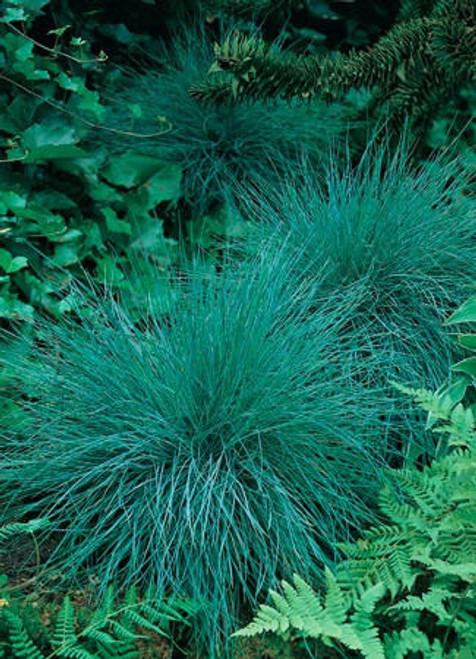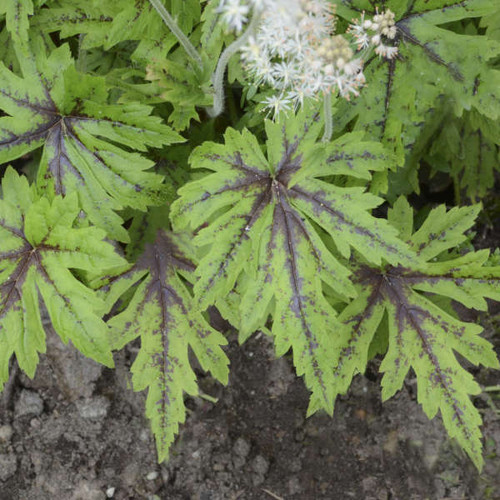Product Description
Festuca a. 'Perfect Edging' PPAF CPBRAF - Proven Winners® (30)ct Flat
(Festuca arundinacea is also sometimes classified as Lolium arundinaceum or Schedonorus arundinaceus) (PPAF: Plant Patent Applied For - US; CPBRAF: Community Plant Breeders' Rights Applied For - EU)
Common Names: Tall Fescue 'Perfect Edging', Ornamental Grass
Festuca arundinacea 'Perfect Edging' is a distinctive ornamental selection of Tall Fescue, offering attractive variegated foliage and a sturdy, upright habit. Standing taller than the popular dwarf blue fescues (Festuca glauca), this cultivar features eye-catching leaves with creamy white margins bordering a cool, blue-green center. The variegation is particularly vibrant in spring as new growth emerges. In early summer, airy tan flower plumes rise significantly above the foliage, catching the light and remaining upright through the season, eventually maturing into persistent seed heads that complement the foliage tones. Beyond its ornamental value, 'Perfect Edging' retains the toughness of its species, contributing to soil stability and offering visual interest throughout the year.
'Perfect Edging' combines visual appeal with resilience:
- Variegated Foliage: The standout feature is its blue-green leaf blades neatly edged with creamy white. Variegation is most pronounced on fresh spring growth.
- Upright Flower Stalks: Produces tall, sturdy flower scapes that hold the airy tan blooms well above the foliage mound.
- Cool-Season Grower: As a cool-season grass, it performs best and grows most actively during the cooler temperatures of spring and fall. It may slow down during intense summer heat.
- Seasonal Interest: Offers multi-season appeal with its spring variegation, summer flowers, persistent tan seed heads, and potential for evergreen or semi-evergreen foliage in milder climates.
- Drought Tolerant: Once established, it requires minimal supplemental water.
- Salt Tolerant: Suitable for planting near walkways, driveways, or coastal areas where salt spray or runoff may occur.
- Deer Resistant: Generally not favored by deer.
- Erosion Control: The dense root system makes it effective for stabilizing soil on slopes and banks.
- Patent Protection: PPAF and CPBRAF status indicates it is a new variety with propagation rights protected.
- Habit: Forms a neat, dense clump of upright to arching foliage. It is a cool-season bunchgrass.
- Foliage: Leaf blades are moderately textured, featuring distinct creamy white margins and a blue-green center. The foliage mound reaches a height of 14 to 18 inches (35−46 cm). It may remain evergreen or semi-evergreen in the warmer parts of its hardiness range (approx. Zones 6-7), turning bronze or tan in colder areas (Zones 3-5) during winter.
- Flowers/Seed Heads: Airy, tan-colored panicles (flower clusters) emerge in early to midsummer on tall, upright scapes reaching 30 to 34 inches (76−86 cm). These persist into fall and winter, providing textural interest.
- Size: Mature foliage clump spread is typically 18 to 24 inches (46−61 cm).
- Foliage Height: 14 - 18 inches (35−46 cm)
- Flower Scape Height: 30 - 34 inches (76−86 cm)
- Spread: 18 - 24 inches (46−61 cm)
- Foliage Color: Variegated (Creamy-white margins, Blue-green center)
- Flower Color: Tan shades
- Bloom Time: Early Summer to Midsummer
- Hardiness Zones: USDA Zones 3 - 7
- Sun Exposure: Full Sun (more than 6 hours direct sun) is preferred; tolerates Part Shade (4-6 hours direct sun), though variegation may be less intense.
- Water Needs: Low (Drought Tolerant once established)
- Soil: Adaptable; tolerates poor soil quality but prefers well-drained conditions. Tolerant of neutral pH (likely adaptable to slightly acidic or alkaline).
- Growth Rate: Medium
- Origin: Species native to Europe, North Africa, West and Central Asia. 'Perfect Edging' is a cultivar. (Non-native to North America).
- Status: PPAF (US), CPBRAF (EU)
- Features: Deer Resistant, Salt Tolerant, Drought Tolerant, Easy to Grow, Erosion Control, Attractive Variegated Foliage, Container Suitable, Border Plant.
Native Habitat
The species Festuca arundinacea (Tall Fescue) is native across a wide range including Europe, North Africa, and temperate regions of Asia. It has been introduced and has naturalized in many other parts of the world, including North America, often used for pasture, turf, and erosion control. 'Perfect Edging' is a specific cultivar selected and bred for its unique ornamental characteristics, particularly its variegated foliage, and does not have a native habitat itself.
Landscaping Design Tips
'Perfect Edging' offers excellent design possibilities with its texture, color, and structure:
- Mid-Border Placement: Its foliage height (14-18 inches) and taller flower scapes (30-34 inches) make it ideal for the middle ground of perennial borders, providing structure and vertical interest.
- Mass Planting: Planting in drifts or masses creates a striking visual texture and highlights the variegated foliage. Space plants about 18-24 inches apart for good coverage. Highly effective for stabilizing slopes or creating low-maintenance, modern-looking meadows.
- Edging: While named 'Perfect Edging,' its height makes it better suited for defining broader pathways, driveways, or the edges of larger garden beds rather than low, formal edging.
- Containers: Suitable for larger containers, where its upright habit and variegated foliage can be appreciated up close. Ensure good drainage.
- Texture and Contrast: Use its fine-to-medium texture to contrast with bold, broad-leaved plants like Hostas, Heuchera, Sedum 'Autumn Joy', or Coneflowers (Echinacea).
- Garden Styles: Fits well into Eclectic gardens, modern or contemporary designs (due to its clean lines and structure), coastal gardens (salt tolerance), and low-water landscapes (xeriscaping).
- Year-Round Interest: Provides visual interest beyond the growing season with its persistent structure and seed heads, especially attractive when dusted with frost or snow.
Hardiness
Festuca arundinacea 'Perfect Edging' is hardy in USDA Zones 3 through 7. As a cool-season grass, it thrives in regions with moderate summer temperatures and cool spring/fall growing periods.
- In Zones 6-7: Foliage may remain semi-evergreen or evergreen through winter, possibly taking on bronze tints.
- In Zones 3-5: Foliage will typically go dormant, turning tan or brown in winter. This is normal, and new growth will emerge in spring. It is generally resilient and performs well within its designated hardiness range.
Planting and Cultivation
This ornamental grass is relatively easy to grow and maintain:
- Timing: Plant in spring or fall, the periods of active growth for cool-season grasses. Avoid planting during peak summer heat. (Current date: May 2, 2025 - Spring planting is ideal now in most of its zones).
- Location: Full sun promotes the best growth and most vibrant variegation. It can tolerate partial shade, but performance might be reduced.
- Soil: Adaptable to various soil types, including poor soil, provided it is well-drained. Avoid constantly wet or waterlogged conditions. Tolerates neutral pH but is generally adaptable.
- Planting: Dig a hole as deep as the root ball and slightly wider. Place the plant so the crown (base where leaves emerge) is level with the surrounding soil. Backfill and water thoroughly.
- Spacing: Space plants 18 to 24 inches (46−61 cm) apart to allow for mature size and air circulation.
- Watering: Water regularly during the first growing season to establish roots. Once established, it is drought-tolerant. Provide supplemental water only during extended periods of drought, especially in hot weather.
- Fertilizing: Tall Fescue typically has low fertility needs. Supplemental fertilizer is often unnecessary, especially in average garden soil. If growth seems poor, a light application of a balanced, slow-release fertilizer in early spring can be applied.
- Maintenance: Very low maintenance. The primary task is cutting back the old foliage in late winter or early spring (around February or March) before new growth begins. Cut the clump back to about 3-4 inches (7−10 cm) above the ground. Rake out any dead leaves from the center. Division is usually not needed for many years but can be done in spring or fall if the clump becomes oversized or the center loses vigor.
- Pests and Diseases: Generally trouble-free. Occasionally, rust may appear in very humid conditions but is usually cosmetic. Good air circulation helps prevent fungal issues. It is notably deer resistant and salt tolerant.
Thirty (30) plants per flat (or tray). Approximate Plug Measurements: 3 inches deep x 2 inches wide.
Other Details
The most important part of the plant is its root system. Healthy roots are the foundation of a healthy, vibrant plant. The type of plug container used is based on the specific needs of the plants. Perennials offered as bare root traditionally perform better when planted as bare root.Planted in a specialized mix, potted plants have well established root systems. Top growth stage will vary depending on the current life cycle and time of year when shipped. In Winter and early Spring dormant plants may be shipped. Dormant plants may be planted right away, even before the last frost date.
Most bare root varieties are field grown for at least one season, though Hemerocallis and Hosta are grown for two seasons. The bulk of the soil is removed during the harvesting process and the tops of most varieties are trimmed back to the crown. They are graded, packed in shredded aspen or sphagnum moss and stored in freezers until ready to be shipped.
See our Container Sizes and Bare Root Perennials pages for more information.
Plant information and care is provided in the Overview section, Plant Genus Page and general information is provided in the Planting Care & Guides. Additional questions can be asked on each Plant page.
Plant Spacing: Using the maximum mature spread or width of a plant to guide spacing, ensures space to grow to full size. To fill an area sooner, plant them closer together. Just remember, future thinning or transplanting may be needed.
Water: Keep a close eye on newly planted perennials, especially throughout the first growing year. Most early plant loss is due to too much or too little water!













